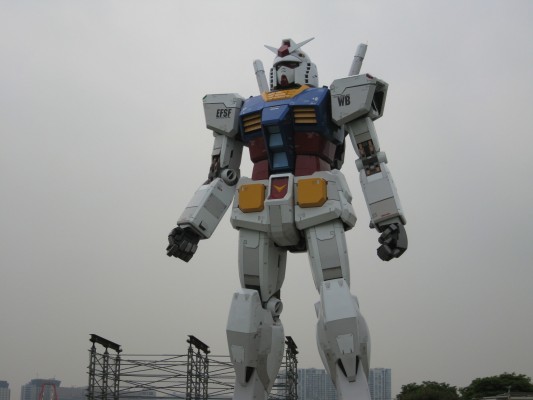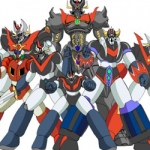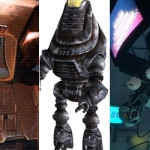
Guess which anime we're talking about today?!
Hey, hey, HEY fans! Welcome to the second part of Massive Mecha Month, here on Happy Fun Thursdays! Last week, I introduced Mazinger Z as the great-granddaddy of all the mecha anime. This week, I’m showcasing two very different mecha anime that follow the footsteps of Mazinger Z, and essentially break the new genre into two subsets, simultaneously expanding and restricting the realm of mecha itself. The first introduced the world to heroes who drove vehicles that combined together to form robots of monsters of various shapes and sizes, while the other introduces a world torn apart by a war fought using technologically advanced mobile suits that actually follow the laws of physics! I am, of course, referring to Getter Robo and the original Mobile Suit Gundam.
Getter Robo was made by one of the co-creators of Mazinger Z, Ken Ishikawa, and was released in 1974. It followed the success of the Mazinger Z and the Science Ninja Team Gatchaman (later known as Battle of the Planets in the US), but, instead of being another run-of-the-mill robot anime, it pioneered the “combining-robot” concept: the three teenage heroes each had their own fighter jets which combined to form a single, giant robot. Depending on configuration of each of the fighter jets, a different robot would form: Getter-1, to fight flying monsters; Getter-2, to fight grounded or even underground monsters; or Getter-3, to fight undersea monsters. Of course, in order to do this, the law of the conservation of mass, or even all the laws of basic physics, were thrown straight out of the window! This particular sub-genre of mecha anime followed a format similar to that of Mazinger Z, which was to have heroes stave off an evil alien force through the use of a mecha that was not bound by normal science or logic. Getter Robo essentially continued the Super Robot tradition of mecha anime, and its influence is still being felt in recent mecha anime, like Tengen Toppa Gurren-Lagann and, in some of its physics-defying and monster-of-the-week aspects, Neon Genesis Evangelion.
On the other side of the coin, Yoshiyuki Tomino gave the world a different type of robot show. Instead of the now-stereotypical group of idealistic and obviously “good” protagonists trying their best to thwart the alien and “evil” antagonists, the players within the show suddenly had gray areas in their morality, and the “bad guys” actually had an agenda that was not violently evil. Instead of overpowered robots that changed their forms willy-nilly and broke the laws of physics on a daily basis, everyone was fighting in weapons of war that moved according to and within the boundaries set by the science of the show. Instead of robots, the year 1979 introduced the world to the mobile suit, and to the show Mobile Suit Gundam. Suddenly, robots played a part in a serious war drama set in space, and its feel was similar to Star Trek. This show was the basis for the Real Robot sub-genre of mecha anime that is continued by its many, MANY sequels and spin-offs, as well as the Macross franchise and the likes of other anime like Blue Gender and Code Geass.

The original recipe Mobile Suit Gundam.
So, with that, the stage is set for the influx of several anime using these models as their formula, and we’re only one era away from the modern mecha anime! See you next week, fans, when we get a look at the more massive mecha this month!







 After finding out that the school's library was a welcome respite from the heat of the tropical island he inhabited, Paolo Jasa found out that books were a whole lot better than being a constant target during P.E. class; so much so that he developed a love for them that would last him a life time. His first forays in Science Fiction were in the novels of the esteemed I. Asimov, R. Bradbury, and D. Adams, while his adventures in Fantasy took him to the realms of Discworld, Hogwarts, and a Chicago that houses the only Wizard-For-Hire found in the local Yellow Pages, Harry Dresden.
After finding out that the school's library was a welcome respite from the heat of the tropical island he inhabited, Paolo Jasa found out that books were a whole lot better than being a constant target during P.E. class; so much so that he developed a love for them that would last him a life time. His first forays in Science Fiction were in the novels of the esteemed I. Asimov, R. Bradbury, and D. Adams, while his adventures in Fantasy took him to the realms of Discworld, Hogwarts, and a Chicago that houses the only Wizard-For-Hire found in the local Yellow Pages, Harry Dresden.